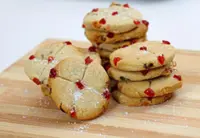Serve the cakes immediately or keep them warm over a bare simmer until needed. — Photos: LOW LAY PHON/ The Star
IF you look up ma lai go, you’ll find it listed as a classic dim sum dessert from Hong Kong. However, the name itself hints at its origins: “ma lai” means Malay and “go” means cake.
The story of ma lai go is believed to have started during the British colonisation of Malaya.
The British, craving cake, faced challenges due to the scarcity of milk and the absence of ovens.
Local Malay cooks ingeniously substituted coconut for dairy and steamed the cake instead of baking it.
The colonialists loved this Malay sponge cake so much that they introduced it to their other colony, Hong Kong.
There, Cantonese chefs adapted the recipe further, using evaporated milk instead of coconut milk and developing a yeast batter.
Over time, this cake became a staple in Cantonese dim sum culture and was, along the line, recognised as the national cake of Hong Kong by CNN.
My first experience with ma lai go was as a child, staying overnight at our uncle’s house in Penang. I had woken up before the sun had fully risen and our aunt just handed me a cup of coffee from her huge kettle and a sponge cake, its name unknown to me at that time.
That first bite was unforgettable: the unmistakable coconut flavour, the warm steam and the moist, crumbly texture. It was unlike any cake I had ever tasted.
Later, I discovered that modern ma lai go recipes no longer use coconut milk.
Determined to reclaim the memory of true Malay sponge cake, I developed this recipe with ingredients reminiscent of the colonial era, emphasising the cake’s Malaysian roots.
It took me four attempts to perfect this technique.
A crucial tip: do not fold in the flour until you are ready to pour the batter into the moulds, because the air in the egg begins to collapse once the flour is added.
Also, ensure the water is at a rolling boil before placing the cake in the steamer. Timing is key. Have everything prepared in advance.
First, sift the dry ingredients, then whisk the eggs with the sugar.
Second, bring the steamer to a rolling boil, then melt the butter for greasing the moulds.
Third, melt the butter and fold in the wet ingredients.
Finally, fold in the dry ingredients and pour into the moulds, then immediately pop into the steamer for 30 minutes.
Do not open the lid during steaming, so ensure there’s sufficient water in the steamer for the entire 30 minutes.
Since this is not a yeast batter recipe, it is best to steam this cake in smaller moulds or muffin pans rather than in a large cake tin.
This allows the heat to penetrate the centre of each cake, ensuring they rise properly.
My wife finds the soda’s pungency in the cake a bit too strong, but that’s the flavour I associate with ma lai go.
You may reduce the soda bicarbonate if preferred but it may require some experimentation. A yeast batter would eliminate the need for soda bicarbonate or baking powder altogether.
Once steamed for 30 minutes, the cake will not collapse if it’s risen properly. Serve the cakes immediately or keep them warm over a bare simmer until needed.
Ma lai go is best enjoyed with local black coffee, or teh tarik. Happy Merdeka to all my fellow Malaysians.
Ma lai go
Ingredients
4 eggs
125g light brown sugar
80g unsalted butter, melted
½ tsp vanilla
100ml coconut milk
¼ tsp salt
100g self-raising flour
30g custard powder
1 tsp soda bicarbonate
Directions
Whisk the eggs with sugar until fluffy and tripled in volume.
Gently fold in melted butter, salt, coconut milk and vanilla until combined.
Grease about 10 individual moulds with melted butter, or line a cake tin with baking parchment.
Sift flour, custard powder and baking soda, then by hand gently fold the dry ingredients into the wet mixture until just combined.
Pour the batter into the greased moulds and steam over boiling water for 30 minutes until fully cooked.
Serve immediately while hot, or keep warm in a steamer over a bare simmer.










